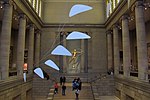Live 8 concert, Philadelphia

On 2 July 2005, a Live 8 concert was held in Philadelphia, Pennsylvania, United States, in front of the Philadelphia Museum of Art, with a densely packed audience stretched out for one mile along the Benjamin Franklin Parkway. The event was organized by the ONE Campaign. It was one of the first Live 8 concerts announced, as the city had played host to its Live Aid predecessor in 1985, and, until the inclusion of a concert outside Toronto, was the only city in North America to represent Live 8. It did, however, remain the only United States city to participate in the event. The event is also referred to as "Live 8 Philadelphia", "Live 8 Philly", or "Live 8 USA". Unlike other venues, no tickets were issued to control access, and Philadelphia police declined to give a crowd estimate. Presenters stated several times on stage that over one million people were at the concert. Non-organizer estimates ranged from 600,000 to 800,000 and one million to 1.5 million. Some estimates are of the number of people at the concert at any one time, while other estimates are of the total number of people on the Parkway over the course of the nearly eight hours-long event.
Excerpt from the Wikipedia article Live 8 concert, Philadelphia (License: CC BY-SA 3.0, Authors, Images).Live 8 concert, Philadelphia
Eakins Oval, Philadelphia Center City
Geographical coordinates (GPS) Address Nearby Places Show on map
Geographical coordinates (GPS)
| Latitude | Longitude |
|---|---|
| N 39.964 ° | E -75.18 ° |
Address
Eli Kirk Price Fountain
Eakins Oval
19130 Philadelphia, Center City
Pennsylvania, United States
Open on Google Maps






